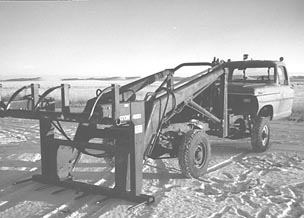
You've never seen a loader "tractor" like the one built by Ronald Fulbright, Coffee Creek, Mont., that consists of a Dual front-end loader and grapple fork mounted on the front of a cut-in-half 1972 Ford 3/4-ton 4-WD pickup.
Fulbright primarily uses the high-speed rig to stack and feed 2-ton rectangular hay bales.
"We call it the Grabbit. It'll outwork three new tractors because it moves at pickup speeds," says Fulbright, a cow-calf operator who built the rig three years ago with help from his son Jed. "We already had the pickup and loader and spent little to build it."
Fulbright first stripped the back end of the pickup down to the frame, and then cut it off and remounted it on the front end of the pickup. He then mounted the Dual loader on the truck frame. The front wheels (formerly the rear wheels) are fixed while the original steering axle is still under the cab.
He moved the pickup's 4-speed transmission and transfer case 11 1/2 in. ahead in order to make room for another transfer case that he took off a 1967 Chevy pickup. He made a short driveshaft that connects the two transfer cases together. He then ran a driveshaft from the add-on transfer case up to the front drive axle (originally the pickup's rear axle).
He raised the cab 4 in. by mounting steel blocks on each side of the steering axle, making room for the front driveshaft. He also fitted each side of the steering axle with rubber overload springs. The springs almost double the rig's load capacity so, to keep the axle from bending or breaking, he welded a length of 1-in. sq. high tensile steel (off an old rod weeder) to the bottom of the axle. He wrapped a chain around both sides of the axle and frame to limit how far the axles can move up off the springs so that the pickup can't tip over on rough ground.
The pickup didn't have power steering so Fulbright installed the power steering sector and pump from a 1975 Chevrolet Caprice.
The loader is powered by a 16 gpm hydraulic pump that mounts ahead of the engine. He moved the radiator and fan ahead 24 in. and used a pair of U-joints connected by a slip shaft to shaft drive the pump off the engine crankshaft. The pump sends oil to a remote 3-speed valve mounted at the base of the loader that has cables going up to the cab. The cables are controlled by three levers -- one to raise or lower the loader, one to tilt the bucket, and one to operate the grapple fork. He also ran a shaft directly off the water pump up to the repositioned fan.
"People scratch their heads and wonder what it is until they see it work, then some of them laugh," says Fulbright. "However, they don't laugh when I pass them on the road with a trailer load of bales while they're still driving to the field on their new tractors. It rides a little rough but that isn't a problem. It took two years to build in our spare time. It's highly maneuverable and lets me load and unload big 4 by 4 by 8-ft. bales in comfort in the winter.
"We can go up to 50 mph in the field if it's not too rough. I can unload bales from a semi trailer and pup trailer combination and stack them in only about 20 minutes. The short wheelbase makes it highly maneuverable. The pickup's original engine was worn out so I replaced it with a V-8 Super Cobra Jet gas engine out of an old Mustang car. The 420 cu. in. engine has about 400 hp and is equipped with a high performance ceramic clutch. It has more than enough power. I replaced the original tires with Michelin 7.50 by 16, 14-ply off-road tires that can withstand the impact of heavy loads over rocks, etc., at high speeds. We put chains on the tires whenever we have to use it in deep snow.
"Most of the loader's weight is over the front axle. We 'fish plated' the entire frame for added strength and mounted a screen over the radiator in order to keep chaff and hay from causing the radiator to overheat. We mounted a light on back of the cab and put a spotlight on top of it for feeding bales at night during the calving season. We also cut a 2 1/2-in. dia. hole in the bottom of the bucket so we can tow it with the gooseneck ball on our flatbed pickup. It lets one person pull the loader tractor to other fields."
